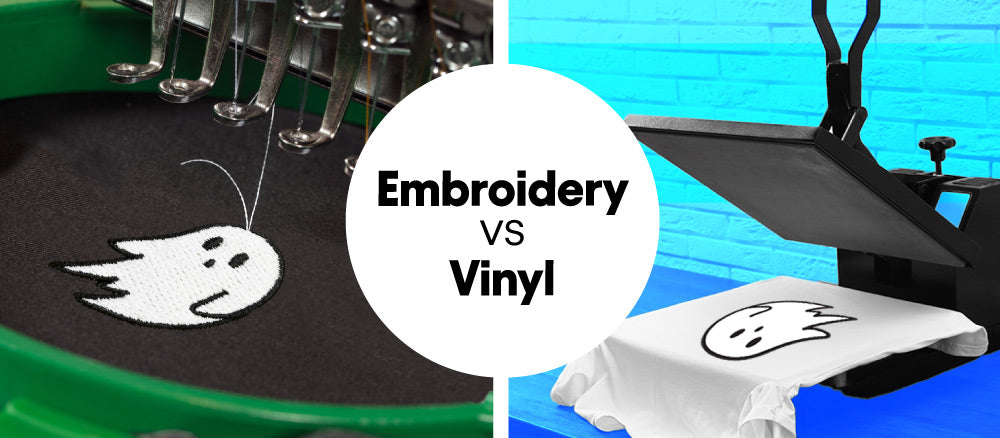
Embroidery vs. Vinyl Clothing: Is Vinyl or Embroidered Best?
Share
Looking to customize your apparel by adding logos and other designs?
Since vinyl and embroidery are the two primary options, it can be difficult to choose between vinyl vs embroidery. Although they’re both applied to fabric, the process, material used, and decorative look are distinct.
Understanding their differences will help you determine which method is right for you.
Continue reading for our comprehensive guide on embroidery vs. vinyl.

What’s the Difference Between Vinyl and Embroidery?
The main difference between vinyl and embroidery is how they’re applied to the fabric. While embroidery involves stitching a design into textiles using thread and a sewing needle, vinyl uses a combination of heat and pressure to transfer the custom design onto a piece of cloth.
With embroidery, an embroiderer designs the shapes and stitches differently colored thread into it by hand or using a machine. An embroidery thread is usually raised from the surface of the cloth, drawing attention to the design. It’s a preferred form of customization for items like hats, hoodies, premium t-shirts, and sweatshirts.
The other customization method uses a specialized tool to cut the vinyl into different shapes, fonts, letters, and designs. Once cut, they’re laid in a heat press against the cloth and transferred onto it. Vinyl is commonly used on t-shirts, singlets, hi-vis vests, and more for mostly promotional purposes by small businesses.

Embroidery vs. Vinyl Comparison Chart
Choosing between embroidered or vinyl fabric can be tough. Check out the comparison chart below to learn their main differences.
|
Comparison |
Embroidery |
Vinyl |
Winner |
|
Pricing |
Low cost |
High cost but robust |
Embroidery/ Vinyl |
|
Longevity |
Very Durable |
Not long lasting |
Embroidery |
|
Large patterns |
Efficient with an embroidery machine |
Fast |
Embroidery/Vinyl |
|
Heavy or more expensive fabrics |
Effective |
Ineffective |
Embroidery |
|
Thin fabrics |
Damaging |
Effective |
Vinyl |
|
Color options |
Doesn’t allow color gradients |
Uses color gradients |
Vinyl |
|
Turnaround time |
About 7-10 business days |
About 10-14 business days |
Embroidery |
|
|
|
|
|
|
Overall winner |
|
|
Embroidery |
A Deeper Look at Our Vinyl vs. Embroidery Comparison
Have difficulty choosing an imprinting method? The vinyl vs. embroidery guide below will help you make an informed decision.
Embroidered or Vinyl: Which One is Cheaper?
Should I go for embroidered or vinyl when on a budget? Cost can be one of the biggest deciding factors if you need promotional clothing or branded workwear.
If you’re on a budget and the lifespan of your fabrics is short, vinyl can be an economical choice. It’s a low-cost way of decorating garments with simple designs. However, the prints may not be durable.
On the other hand, the upfront costs of an embroidery design can be very high. But it can be a worthy investment since it lasts longer. For both techniques, the price may rise or decrease depending on the complexity of the design.
Winner: A Draw
One thing we figured out is that neither customization option will always be cheaper. The more cost-effective option will depend on factors like the complexity of the design, the quality of the imprints, and where you have the work done.
Vinyl vs. Embroidery: Longevity and Durability
While vinyl may be low-cost, it isn't very resilient and won’t last as long. If the clothing sees continuous use, the vinyl elements will start to break and peel or fade away over time.
Damage can be more prevalent if you don’t take good care of your vinyl-printed garment. For instance, washing at the wrong temperature or pressing on the wrong side can damage your fabric.

Embroidered fabrics don’t have these issues. They use sturdy threads that can withstand laundering, bleaching, and frequent rubbing. What’s more, it can last a long time thanks to the high-quality stitching.
Whether you want embroidered hats, shirts, or hoodies, ensure the stitches are high-grade. Low-quality stitching tends to easily tear or snag over time.
Winner: Embroidery
Regarding longevity and durability, embroidery is the superior option. We found that embroidered designs sewn into the garments tend to last much longer than a vinyl-printed design produced on top of fabrics. They are also less prone to fading or getting damaged.
Embroidery vs. Vinyl: Large Patterns
Vinyl is great for larger designs. It is not only cost-effective but also makes large logos and print designs look sharper. Additionally, the imprint feels much lighter on clothing.
Compared to vinyl, it can be hard to embroider large designs by hand as it can be time-consuming. However, there are embroidery machines that can also handle larger patterns.
Winner: A Draw
For larger designs or logos, we recommend that you go for either vinyl or embroidered personalization. Both embroidery and vinyl printing can get the job done. But ensure you opt for an embroidery machine instead of hand-made embroidery for large fonts and patterns.
Embroidery or Vinyl: Heavier & More Expensive Fabrics
For hoodies and other thick/expensive items, you may be torn between using machine embroidery or vinyl. Not anymore.
Embroidery works well on high-quality thicker clothing like hoodies, corporate shirts, hats, military uniforms, and sweatshirts. These garments are very resistant to embroidery needles, so they won’t get damaged. For instance, when you check out how to embroider a hat, you will notice that the hat never puckers.
Embroidered designs also look more prestigious on expensive fabrics. They give clothes a professional appeal that communicates quality and experience. This is why they’re mostly used in military and corporate clothing.
On the contrary, vinyl may not look good on heavy and expensive fabrics. They can make your classy clothes look casual.

Winner: Embroidery
For high-quality thicker clothing, consider embroidering. They can withstand sewing needles. Besides, they can make your clothes look chic and professional.
Vinyl and Embroidery: Which is Best for Thinner Fabrics?
Need lighter fabrics like nylon or rayon customized?
Embroidery may not be an ideal solution. These fabrics are less resistant to sewing needles. They can be weighed down, crease, or tear during embroidery.
If you want to tailor delicate fabrics, consider vinyl. Unlike embroidery, they don’t use needles. They utilize ink and heat curing, which helps preserve the structure of lighter clothing.
Winner: Vinyl
Vinyl printing is the best choice for thinner garments since it protects their structure during the customization process compared to embroidery.
Embroidery and Vinyl: Color Options
Embroidery is the best option to gradient colors. This is because embroidery uses spacing and stitches to achieve the subtle thread color changes of one color fading into another. They are a more suitable choice for gradient color designs. You can print complex designs that need gradient colors such as rainbow designs that involve color fades.
On the other hand, vinyl is ideal for the production of crisp lines and sharp corners. It allows you to create solid images in fabrics. Heat transfer vinyl color options are limited to stock colors as produced by the manufacturer.
Winner: Embroidery
Embroidery allows you to experiment with colors. You can create intricate and appealing designs that involve color gradients.
Vinyl vs. Embroidery: Turnaround Time
The general turnaround time for vinyl is 7-10 business days while embroidery takes 10-14 business days. Thanks to technology, embroidered designs can be digitized so a machine can reproduce them fast. However, these times aren’t set in stone.
To get a time estimate, consider parameters like design size, the complexity of the design, the number of orders, and machine speed.
Winner: A Draw
On turnaround time for embroidery vs. vinyl, it can be hard to find a clear winner. Various factors can affect the speed of each customization option.
Check Out Our Embroidered Hats Here!
Vinyl or Embroidery: Which is Better? Final Verdict
This is a difficult question. Vinyl works well with delicate fabrics and allows for more colors and detail. But embroidery is more durable. It also does a better job than vinyl in quality and professionalism. Your choice of customization will depend on your needs.
Vinyl vs. Embroidery FAQs
Can I use a heat press on embroidered fabric?
Yes, you can! The heat press machines can harden the embroidery, making them less likely to fray. Top press the embroidery for 12-15 seconds and bottom press (inside out) for 10-12 seconds. Firmly clamp down the press to apply adequate pressure and heat transfer on the embroidery.
Does color affect the price of vinyl?
Yes, it will. Creating color gradients is a complex process and can increase the costs of vinyl customization. Factors that may affect color retention include sunlight intensity and exposure frequency. You can avoid this using vinyl made of high-quality UV-resistant plasticizer, which is a little more expensive but long-lasting.
Is embroidery good for lighter fabrics?
No, it isn’t. The needles can damage the fabric. Worse still, sewing machine holes may also show on the final product. Flimsy and thin fabrics like rayon and silk aren’t suitable for the embroidery process. The best fabric for embroidering are cotton, linen, denim, canvas, and wool.
Does embroidery last longer than screen printing?
Yes, embroidered designs are more durable. Embroidery also requires less maintenance than screen printing, giving you more value in the long run. In addition, screen printing takes more time, is costly, and is limited to thin fabrics, making embroidery an excellent choice for many applications.
